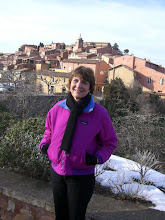Last summer we saw a remarkable documentary called Into Great Silence which shows the daily life of a group of contemplative monks living in the French Alps near Grenoble. Just last week we were able to visit one of the contemporary monastères habités (“inhabited monasteries”) in France, l’Abbaye Notre-Dame de Sénanque. Located in an isolated valley of the Vaucluse just outside of Gordes, the Cistercian abbey is virtually surrounded by lavender fields which must be a beautiful sight in July when the flowers are in full bloom.
For six euros we took part in a guided tour of the buildings, which provided information on the history of the Cistercians and Sénanque as well as the architecture of the monastery. Our guide explained that in the eleventh century a Benedictine monk named Robert Molesme had become disillusioned with his order, which, in his eyes, had strayed from the rigor and simplicity espoused by Saint Benedict. The “reformed”
Named after la rivière Sénancole which runs through the property, l'Abbaye de Sénanque was founded in 1148 and reached its high point in the thirteenth and fourteenth centuries when over a hundred monks ran four mills and worked many plots of land. Disbanded when the abbey was sold after the French Revolution and once again in 1904, monks have been living in the monastery since 1988, though they presently only have a community of six.
Considered an example of pure medieval Cistercian architecture, all of the rooms at Sénanque are beautiful in their simplicity. Apparently modeled on Roman building styles, the walls were built to a certain height, then sandbags and a wooden arch were put in place, to be removed once the bricks of the arch were complete.

No comments:
Post a Comment